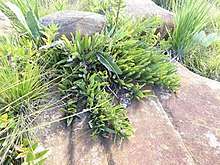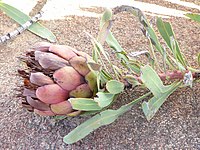Protea parvula
Protea parvula, also known as the dainty sugarbush,[1][3][4] or kleinsuikerbos in Afrikaans, is a small flowering shrub belonging to the genus Protea.[1][4]
| Protea parvula | |
|---|---|
 | |
| Scientific classification | |
| Kingdom: | Plantae |
| Clade: | Tracheophytes |
| Clade: | Angiosperms |
| Clade: | Eudicots |
| Order: | Proteales |
| Family: | Proteaceae |
| Genus: | Protea |
| Species: | P. parvula |
| Binomial name | |
| Protea parvula | |
Taxonomy
It was first described in 1958 from Mpumalanga (then part of the former Transvaal province) by John Stanley Beard.[2]
Description
It is a low-growing, creeping, shrubby groundcover, growing only up to 16cm in height.[4]
Sources differ on the ability of this species to survive wildfires. According to one source it is long-lived, with plants surviving over a century, and can regrow after fire from an underground bole or rootstock,[1] another source states the plant is killed by fire.[4] The seeds are released by the plant as soon as the woody fruit is ripe, from April to July, and are dispersed by the wind.[1][4] The seeds are fire-proof, and simply lie on the ground until germination.[4]
Protea parvula flowers in the summer,[3] from December to March. The plant is monoecious with both sexes in each flower.[4] The flowers are pollinated by birds.[1][4]

Distribution
Protea parvula is found on the slopes of the Drakensberg Mountains, from Mariepskop,[1][4] through Mpumalanga and eSwatini,[1][4][5] to Vryheid in central northern KwaZulu-Natal.[1][4] It grows in rocky, exposed grassland on acid soils, at altitudes of 1,300 to 2,150 meters.[1][4]
Conservation
In 1996 it was assessed as "not threatened" in the Red data list of southern African plants, but in 2009 it was re-assessed as "near threatened", due to an estimated population reduction of 20-30%, caused by a loss of 28% of its natural habitat over the past century. It is primarily threatened by the planting of forests of non-native pine trees (afforestation) as well as mining for soapstone.[1] It may, however, be locally common.[4]
The species is protected in the Malolotja Nature Reserve in eSwatini.[3]
References
- Rebelo, A.G.; Mtshali, H.; von Staden, L. (14 August 2009). "Dainty Sugarbush". Red List of South African Plants. version 2020.1. South African National Biodiversity Institute. Retrieved 11 July 2020.
- "Protea parvula". International Plant Names Index. The Royal Botanic Gardens, Kew, Harvard University Herbaria & Libraries and Australian National Botanic Gardens. Retrieved 20 July 2020.
- "Protea parvula (Dainty sugarbush)". Biodiversity Explorer. Iziko - Museums of South Africa. Retrieved 11 July 2020.
- "Grassland Sugarbushes Sugarbushes - Proteas". Protea Atlas Project Website. 11 March 1998. Retrieved 11 July 2020.
- "Protea parvula Beard". Plants of the World Online. Kew Science. 2017. Retrieved 20 July 2020.
| Taxon identifiers |
|---|